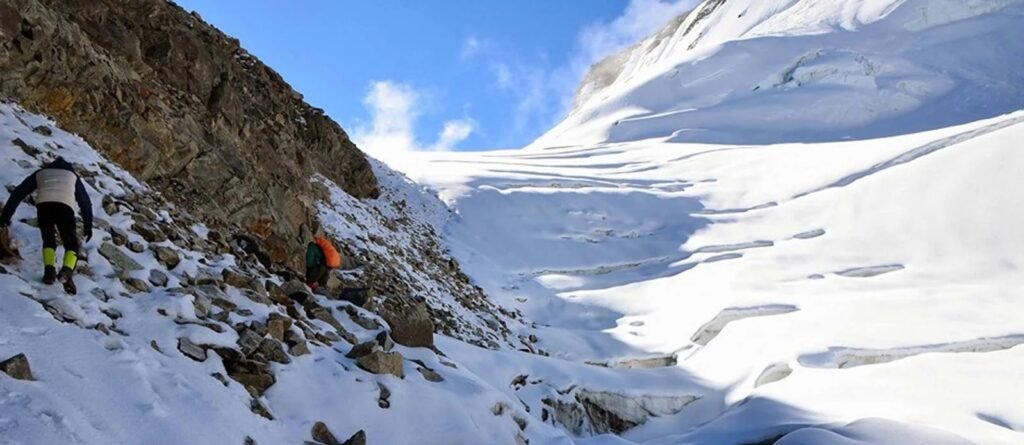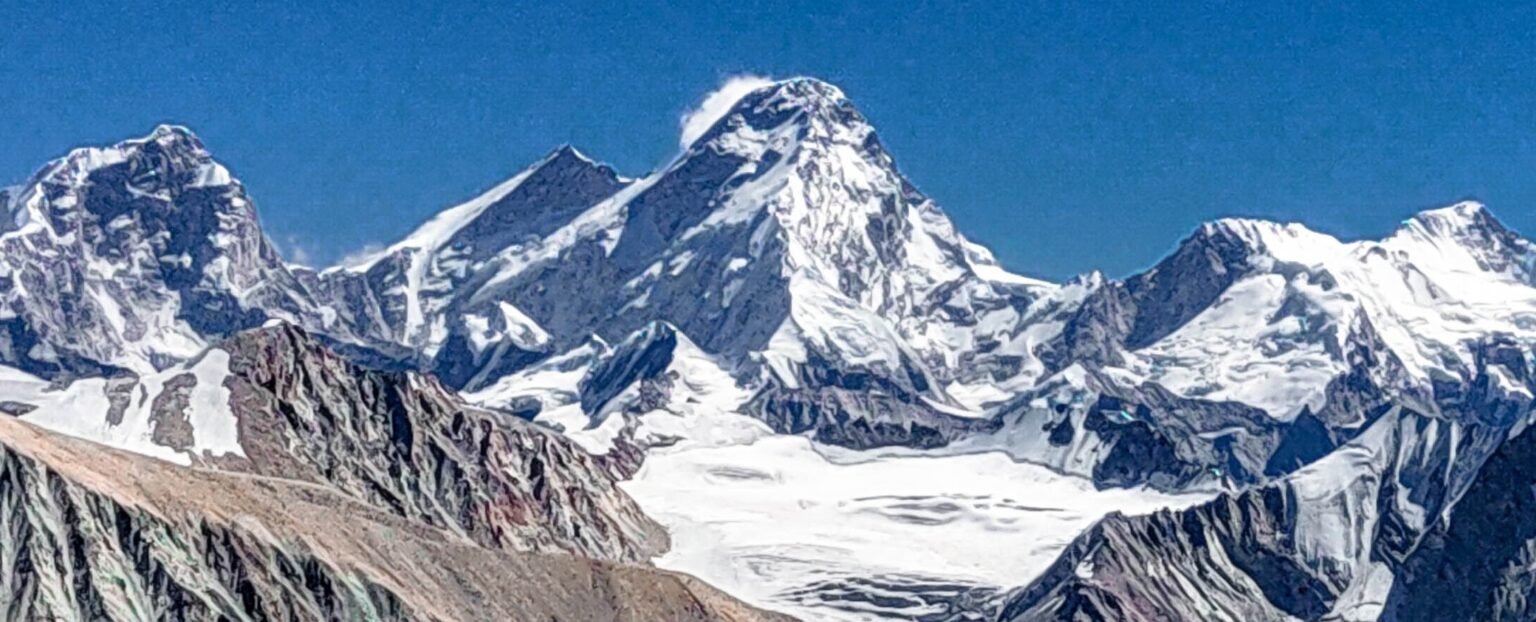Kalindi Pass, also known as Kalindi Khal, is a legendary high-altitude mountain pass that connects the sacred towns of Gangotri and Badrinath, tracing a mesmerising arc through the heart of the Garhwal Himalayas in Uttarakhand, India. Renowned as one of the toughest and most spectacular trekking routes in the Indian Himalayas, Kalindi Pass is the ultimate destination for adventure seekers, spiritual pilgrims, and those in search of untamed Himalayan beauty. The trek through Kalindi Pass offers breathtaking views and a profound connection to nature.
General Trip Charges for Kalindi Pass
Planning your journey through Kalindi Pass can enhance your experience significantly, ensuring you are well-prepared for the challenges ahead.
- Standard Trek Packages: ₹95,000–₹1,30,000 per person (+5% GST), usually covering:
- Trekking permits, insurance
- Experienced guides and porters
- Accommodation (tents/lodges at Gangotri & Badrinath)
- Meals (mostly vegetarian)
- Group equipment (ropes, crampons, etc.)
- Economy Packages: For larger groups, per-person daily rates can drop when sharing resources.
- Deluxe/Premium Options: Higher costs cover more comfort, exclusivity, and extra buffer/acclimatisation days.
- Transport: One-way taxi from Dehradun or Rishikesh to Gangotri typically costs ₹7,000–₹11,000 depending on vehicle and group size.
Pro tip: Always check what’s included! Flight/train tickets, personal gear, snacks, and emergency costs are not usually covered.
Beautiful Places & Landmarks Near Kalindi Pass
- Mt. Shivling, Bhagirathi Group, Thalay Sagar, Meru: Dominant, sacred peaks visible throughout the trek.
- Valley of Flowers National Park: UNESCO World Heritage Site, famed for its alpine flora, accessible from the Badrinath side.
- Hemkund Sahib: Sikh pilgrimage site set beside a pristine glacial lake.
- Auli: Renowned ski and relaxation resort with panoramic Himalayan views.
- Mana Village: India’s last village before the Tibet border and a living relic of ancient Himalayan culture.
Route Highlights
The standard trek itinerary covers:
- Gangotri: Sacred starting point, revered as a source of the Ganges.
- Gaumukh: Glacier snout and true origin of the Ganges river—an awe-inspiring, holy site.
- Tapovan & Nandanvan: High-altitude meadows with surreal mountain scenery.
- Vasuki Tal: A Glacial lake with mythical significance and stunning reflections of Himalayan peaks.
- Sweta Glacier/Kalindi Base/Khara Pathar: Technical, icy terrain with sweeping vistas.
- Kalindi Summit: The pass itself is a dramatic high point flanked by towering peaks.
- Rajparav & Arwa Tal: Descent through pristine landscapes to Mana and Badrinath, a revered pilgrimage town.

A Brief History of Kalindi Pass
- Ancient Trade Route: Historically, the Kalindi Pass was a vital trade route that enabled the exchange of goods between India and Tibet, such as salt, textiles, and other commodities. The region saw traders, pilgrims, and explorers forging connections that left a deep cultural imprint.
- Early Explorers: The pass was first mentioned in 1936 by John Bicknell Auden, a British geologist and explorer, in his survey of the Garhwal Himalaya. Inspired by Auden’s accounts, the first Indian expedition crossed Kalindi Pass in 1945 under Swami Probodhananda and Dileep Singh.
- Mountaineering Feats: Over the decades, Kalindi Pass became a coveted prize for mountaineers, with W.M. Jenner leading the first recorded British ascent in 1932, long before the route grew famous among adventure trekkers.
Location & Geography
| Feature | Details |
| Altitude | 5,942m (19,495ft) |
| Coordinates | 30°55′04″N 79°16′56″E |
| Region | Uttarkashi, Uttarakhand, India |
| Range | Garhwal Himalaya, Greater Himalayas |
| Trek Distance | 71–86km (44–53mi), depending on route |
| Trailhead | Gangotri (base camp) |
| Endpoint | Badrinath or Mana village |
The route traverses glaciated valleys, alpine meadows, and wild terrain dotted with crevasses, moraines, and boulder fields.
Traversing Kalindi Pass is as much a spiritual odyssey as a physical one:
- Mythological relevance: The region is intertwined with Hindu legends, especially the Ganges River and nearby shrines at Gangotri and Badrinath.
- Pilgrimage: Many trekkers combine their adventure with temple visits for a unique blend of adrenaline and spirituality.
Economy and Population
Kalindi Pass itself is uninhabited, with no permanent settlements, only transient camps shepherded by guides and trekkers.
The Trekking Experience
Kalindi Pass is celebrated as the most demanding trek in India. Here’s what to expect:
- Travel Season: Mid-June to mid-September is the ideal trekking window. Permit required.
- Duration: About 14–16 days, depending on weather and acclimatisation.
- Difficulty: Only for experienced trekkers with high-altitude experience, requires fitness, technical skills, and mountaineering know-how.
- Weather: Temperatures range from 5 °C–10°C during the day to as low as -6°C at night.
Cultural and Spiritual Significance
- Nearby Communities: The population around the trail is sparse, mainly in Gangotri, Badrinath, and Mana. Economic activity is driven by:
- Pilgrimage tourism
- Trekking and expedition logistics
- Small-scale hospitality (lodges, camps)
- Agriculture and animal husbandry in the lower valleys
Villagers, especially from Mana and Gangotri, serve as guides, porters, and support staff, playing a crucial role in the trekking economy.
Popular People Associated with Kalindi Pass
- John Bicknell Auden: British geologist who first documented the pass in 1936, inspiring future explorers.
- Swami Probodhananda: Led the first Indian expedition to traverse the pass in 1945, with Dileep Singh as guide.
- Local Heroes: Notable support staff and guides, such as Mahavir from Gangotri, who have assisted many successful crossings and are respected in trekking circles for their experience and resilience.
Conservation and Responsible Trekking
- The Kalindi region is fragile. Respectful, eco-sensitive trekking is crucial: carry waste back, avoid disturbing wildlife, and support local communities to preserve the Himalayan sanctuary for future generations.
Frequently Asked Questions (FAQs)
Why is Kalindi Pass considered the toughest trek in India?
The trail spans glacial moraines, crevasses, boulders, and high-altitude passes, with long distances between camps and unpredictable weather. Technical know-how, acclimatisation, and physical fitness are critical.
What permits are required for the Kalindi Pass Trek?
An innerline permit is needed due to the proximity to the international border and restricted wilderness, arranged via registered trekking agencies.
Which is the best time to trek to Kalindi Pass?
Mid-June to mid-September is the common window, after the snow melt and before winter snows return. Avoid the monsoon peak season due to landslides and weather hazards.
What wildlife or natural wonders can be seen on this route?
Rare alpine flowers, blue sheep, marmots, Himalayan birds, and (rare) snow leopards. The pristine glaciers and vistas of Shivling, Bhagirathi, and Meru peaks are breathtaking.
How much does the full trek cost? What’s included?
Expect ₹95,000–₹1,30,000 per person (+GST), covering guides, permits, food, tents/accommodation, and essential equipment. Excludes personal gear, toiletries, flights/trains, and emergency expenses.
Is there any population or settlement at Kalindi Pass?
No. The region is too harsh for habitation. The only settlements are at the ends, Gangotri, Badrinath, and Mana. The wilderness between is untouched by permanent human presence.
Who are the famous personalities associated with this area?
John Bicknell Auden, Swami Probodhananda, and respected local guides like Mahavir have helped many explorers make the crossing.
What are the notable landmarks along the trail?
Gaumukh glacier, Tapovan, Vasuki Tal, Sweta Glacier, and Mana Village, with highlights being the views of the major Garhwal peaks.
In Conclusion
Kalindi Pass isn’t just a trek, it’s a challenge, a spiritual journey, and a chance to stand at the doorway between earth and sky, surrounded by Himalayan majesty. Whether you’re seeking a life-changing adventure, a deeper connection to Himalayan culture, or simply the thrill of the world’s toughest landscapes, Kalindi Pass delivers, often beyond what words can capture.
